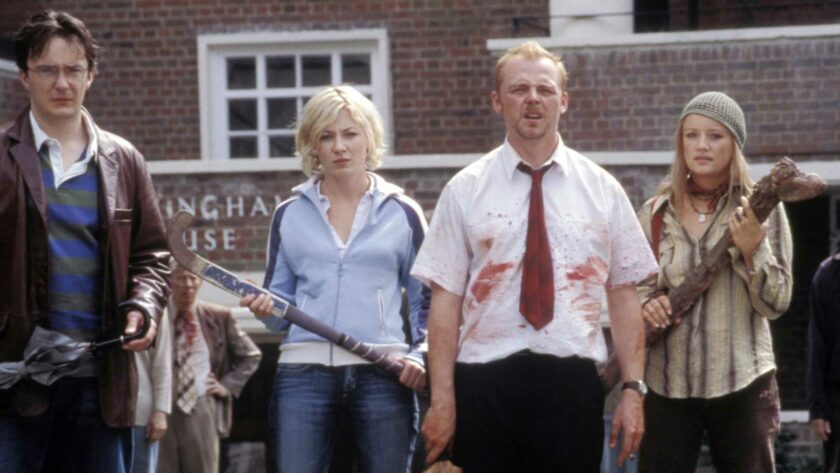Dan Jacobson demystifies epidemiological models through Edgar Wright’s Shaun of the Dead.
It was only a matter of time before the outbreak of COVID-19 caused a worldwide shift towards armchair epidemiology. Whilst this outbreak has triggered an incredible global, collaborative, scientific response with regards to everything from vaccine development to nation-wide tracking (with significant contribution from UCL itself), we have also seen every type of pandemic misinformation come to fruition in the scariest of ways: from conspiracy theories about 5G networks to Didier Raoult’s highly criticised chloroquine study influencing US policymaking to the archetypal Silicon Valley trope “I’m not an epidemiologist, but…” offering the fake illusion of integrity and expertise when none exists.
Incidentally, you probably wouldn’t think that the best preparation for a pandemic would be a hypothetical zombie apocalypse; yet, many of the techniques and strategies which would be applied in this scenario are surprisingly similar. The Center for Disease Control and Prevention in Atlanta – probably the world leader in disease research and response – has been known to release “zombie warnings” as disease-preparedness stunts. The topic has even been debated in the Canadian Parliament.
The first-ever epidemiological model of zombie infection, known as the ‘Munz model’, was created by Philip Munz of Carleton University in 2009, and it’s incredibly simple. Essentially, you separate the population into three groups: susceptible individuals, zombies, and “removed” individuals, and then you use differential equations to model how individuals move between these groups. Susceptible individuals become zombies by being bitten by a zombie, zombies are removed by being killed by susceptible individuals, and removed individuals gradually become zombies again.
Figure 1: The Munz Model
The Munz model is also known as a “compartmental model”, which has been applied to real-life disease outbreaks and epidemics for almost a century. The models are intuitive, incredibly flexible, and can be adapted for any type of infectious disease. And now, they are forming the basis of the models used to predict and react to this year’s COVID-19 outbreak. I’ll come to that in a minute, but for now, let’s focus on zombies.
The Munz model suffers from one huge problem: it uses a terrible definition of a zombie outbreak. Assuming that a real zombie apocalypse would be similar to that which is seen in popular culture, there is not a single case where all removed individuals become zombies. In reality, the model applied will differ depending on which film you choose to watch.
Shaun of the Dead
The epidemiological model behind the zombie outbreak in Shaun of the Dead follows the same basic technique behind these compartmental models. This time, the population is split into four groups: susceptible individuals (S), infected individuals (I), zombies (Z), and “removed” individuals (R), or “dead zombies”. Susceptible individuals become infected by being bitten by a zombie. Infected individuals become zombies at a specified “zombification” rate. Zombies are then removed by being killed by a susceptible individual.
Figure 2: Shaun of the Dead: Model
In terms of population dynamics, this model – though incomplete – is fairly accurate. It is missing the regular population dynamics, such as births, deaths, and emigration, as well as any real intervention measures beyond “removing the head or destroying the brain”. However, as the large majority of Shaun of the Dead takes place over two days, with all “anti-zombie” measures only occurring during the second, these are not concerning. (The only anomaly of this model is Chris Martin, the lead singer of Coldplay, who appears as a zombie late in the film, and then as his human self in the final scene some months later. I will be ignoring this). I will also include only London (population in 2004 ~ 7.4 million) in this model. It is unclear how much the zombie outbreak has spread, but Morrissey declares that there is “Panic on the streets of London”, and motorways out of London are said to be blocked. So that’s encouraging.
However, in the case of Shuan of the Dead, the real challenge is not in identifying the dynamics of the outbreak, but rather correctly estimating the parameters of the model. These are the values used to describe the effect which each part of the model has on the population. In order to properly estimate these parameters, what you really need is data. Unfortunately, Shaun of the Dead doesn’t provide this. A previous study which presented a model of Shaun of the Dead used a nifty statistical technique called Markov Chain Monte-Carlo simulations. However, I cannot be bothered to do this, so instead, I will use a combination of common sense and the fact that I have seen this film far too many times.
The parameters of this model are:
- The transmission rate of a single zombie: this can be roughly translated to mean the average number of susceptible individuals which a zombie will infect per day. I am assuming that this is a standard zombie feature and does not change over the course of the film. I have set this as 5.
- The zombie-killing rate of a single susceptible individual: this is the average number of zombies which are killed by a single susceptible individual per day. As is suggested in the film, there seems to be a minimal response to the zombies until the second day, so this is initially set to zero. Once the second day begins, this is increased to 5, and later on in the day is increased to 10.
- The “zombification rate”: this is the average rate with which infected individuals become zombies, which can be estimated as the reciprocal of the time spent infected. I have estimated this as 8 hours, as evidenced by Pete (late on Day 1 to early on Day 2), Philip (early on Day 2 to the middle of Day 2), and Barbara (middle of Day 2 to late on Day 2). Ed received multiple zombie bites, which likely explains why his symptoms escalate far quicker than the others.
Figure 3: Shaun of the Dead: Results
According to my model, the outbreak begins around 5 days after the initial infection. By the time Shaun and Ed begin killing the zombies, the zombie count is around 2.1 million. If we assume that infection is irreversible, the final number of susceptible individuals in London is 1.2 million, which seems accurate. Although, at this stage, “accuracy” is somewhat beside the point.
What does this have to do with the COVID-19 outbreak?
In the initial version of this article, written during the very beginning of the UK lockdown, I created my own model of the COVID-19 outbreak, using the exact same principles detailed above, in order to demonstrate how these models could describe a real-life pandemic. However, I decided to remove it, as to not add to the screaming online void of the feared aforementioned armchair epidemiologists. Fortunately, other far more knowledgeable and experienced researchers have done the work themselves.
In the case of the COVID-19 outbreak, its dynamics are far more difficult to ascertain. The best demonstration I have come across of the usefulness of these compartmental models in describing the COVID-19 outbreak was an interactive model developed by Dr Alison Lynn Hill, a Research Fellow at Harvard University, in which you can alter parameters and analyse for yourself the effects of various intervention measures. Hill makes two interesting alterations to the standard SIR model: the first is a latency period (E), during which the individual is carrying the disease, but is not yet infectious. The second is a separation of infectious individuals into mild, severe, and critical cases. Only mildly infectious individuals can infect others, and only critical cases can result in death. As a disclaimer, Hill clarifies that this simulation is for research and educational purposes, owing to the limitations of the model and uncertainties regarding COVID-19 infection. Another COVID-19 projection tool can be found here.
Another example is probably the most widely-circulated model of the COVID-19 outbreak, fronted by Professor Neil Ferguson as part of the Imperial College COVID-19 Response Team. Published on March 16th initially as an agent-based model, and then as a compartmental model, the report predicted, assuming zero-intervention measures, over half a million deaths in the UK and complete overwhelming of the NHS, and has been widely credited for triggering the lockdown measures implemented by the UK government beginning on March 23rd. The key underlying message of the report was the analysis of two intervention strategies: mitigation (slowing the epidemic to reduce the strain on the NHS, otherwise known as “flattening the curve) and suppression (reversing epidemic growth through “wide-scale intensive social distancing”).
It is worth clarifying that these epidemiological models are not predictions, but simulations of potential futures with the intent of influencing the choices we make as a society. Indeed Ferguson has since suggested that, given increased NHS ICU capacity and ventilator availability alongside current social distancing measures, the UK death count will likely stay below 20,000. But, as stressed in Zeynep Tufekci’s fantastic article for The Atlantic, “we have one simple, urgent goal: to ignore all the optimistic branches and that thick trunk in the middle representing the most likely outcomes. Instead, we need to focus on the branches representing the worst outcomes, and prune them with all our might.” With the flexibility of these compartmental models, we can ask a plethora of questions: what could happen if we lift the lockdown after three weeks? Six weeks? What if prior infection is not enough for immunity, and individuals become susceptible again? How long does immunity need to last to prevent a second outbreak before a vaccine is developed? Will there even be a second outbreak?
Additionally, I would like to clarify that my own models could not be classified as predictions either, even if they weren’t describing a fictional zombie apocalypse. I am a first-year PhD student who wanted to learn how to encode differential equations in R because I haven’t left the flat in days. However, I think it is incredibly important that these models are used and discussed. They allow us to think about the effects of our policy decisions and, more importantly, what happens when Londoners do not follow them. The public should know what these “mysterious models” are and how they inform these decisions. So, for now, wash your hands, practice social distancing, and maybe just watch Shaun of the Dead again.
The code which I have used to model the zombie outbreak in Shaun of the Dead can be found on my GitHub.
COVID-19 is a global public health emergency and FilmSoc encourages all readers to follow their government’s advice closely. For UK-specific information, visit https://www.gov.uk/coronavirus.
Shaun of the Dead is available to rent and buy online. Watch the trailer below:







